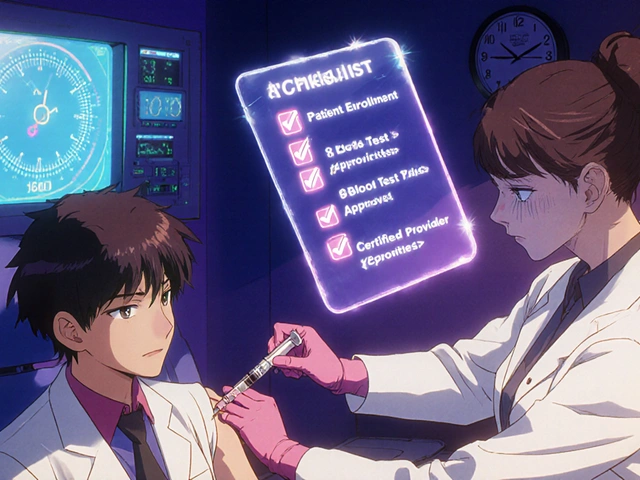Introduction to Carbamazepine
Carbamazepine is a widely prescribed medication primarily used for the treatment of epilepsy and bipolar disorder. I have found it to be an effective medication for managing these conditions, and I would like to share with you the benefits and potential side effects associated with its use. In this article, I will explore the various aspects of carbamazepine, including how it works, the benefits, the possible side effects, and what to do if you experience any of these side effects.
How Carbamazepine Works
Carbamazepine is an anticonvulsant medication that works by stabilizing the electrical activity in the brain. It does this by reducing the number of nerve signals that cause seizures and episodes of bipolar disorder. When I first started taking carbamazepine, I noticed that my seizures became less frequent and less severe, which made a significant impact on my daily life. For those with bipolar disorder, carbamazepine can help prevent episodes of mania and depression, allowing for more stability in mood and overall functioning.
Benefits of Carbamazepine
There are several benefits to using carbamazepine as a treatment option for epilepsy and bipolar disorder. First and foremost, it is effective in reducing the frequency and severity of seizures in people with epilepsy. I have personally experienced a significant improvement in my quality of life since starting carbamazepine therapy.
For individuals with bipolar disorder, carbamazepine can help regulate mood swings and prevent episodes of mania or depression. This allows for a more stable and balanced emotional state, which can lead to improved relationships and overall life satisfaction. Additionally, carbamazepine is often used as a first-line treatment for both conditions due to its proven efficacy and manageable side effect profile.
Potential Side Effects of Carbamazepine
Like any medication, there are potential side effects associated with carbamazepine use. While many individuals do not experience significant side effects, it is essential to be aware of the possibilities and monitor your health while taking this medication. Some common side effects include dizziness, drowsiness, nausea, and vomiting. I experienced mild dizziness and drowsiness when I first started taking carbamazepine, but these side effects diminished over time as my body adjusted to the medication.
More severe side effects can include a rash, low blood sodium levels (hyponatremia), and liver problems. It is crucial to report any severe or unusual side effects to your healthcare provider, as they may need to adjust your dosage or change your medication.
Managing Side Effects of Carbamazepine
There are several strategies that I have found helpful in managing the side effects of carbamazepine. First, it can be useful to take the medication with food to reduce the likelihood of experiencing nausea or vomiting. Additionally, staying well-hydrated and maintaining a balanced diet can help minimize the risk of developing hyponatremia. If you experience dizziness or drowsiness, it is essential to take precautions, such as avoiding driving or operating heavy machinery, until these side effects subside. Finally, it is important to maintain regular communication with your healthcare provider to ensure that your dosage is optimized and that any side effects are properly managed.
Interactions with Other Medications
Carbamazepine can interact with various other medications, which can affect its efficacy or increase the risk of side effects. Some common medications that may interact with carbamazepine include certain types of antidepressants, antifungal medications, and blood thinners. It is essential to inform your healthcare provider of all the medications you are currently taking, including over-the-counter medications and supplements, to ensure that there are no potential interactions that could compromise your treatment.
What to Do If You Experience Side Effects
If you experience any side effects while taking carbamazepine, it is crucial to report them to your healthcare provider as soon as possible. They can help determine whether these side effects are typical and manageable or if they require a change in your treatment plan. In some cases, your healthcare provider may adjust your dosage or switch you to a different medication to alleviate your side effects. It is essential to follow your healthcare provider's recommendations to ensure that your treatment is both safe and effective.
Conclusion
Carbamazepine is a valuable treatment option for individuals with epilepsy and bipolar disorder, providing numerous benefits in managing these conditions. However, it is crucial to be aware of the potential side effects and take appropriate steps to manage them. By maintaining open communication with your healthcare provider, monitoring your health closely, and being proactive in addressing any concerns, you can maximize the benefits of carbamazepine therapy while minimizing the risks. If you are considering carbamazepine as a treatment option, I hope that this article has provided you with valuable information to make an informed decision in partnership with your healthcare provider.








Comments
Susan Cobb
April 30, 2023One must appreciate the nuanced pharmacodynamics of carbamazepine, a drug whose sodium channel blockade is both elegant and clinically indispensable. Yet the literature, far from being a monolith, reveals a tapestry of outcomes that the casual reader often overlooks. The seminal trials of the 1970s, for instance, demonstrated a seizure reduction rate that eclipsed many contemporary antiseizure medications. Moreover, the drug’s efficacy in bipolar disorder is not merely anecdotal; meta‑analyses furnish robust effect sizes that demand attention. Detractors, however, lament the specter of hyponatremia, yet they neglect the fact that diligent monitoring mitigates this risk. Indeed, the incidence of clinically significant hyponatremia hovers around a modest fraction of patients. Likewise, the dermatologic reactions, while potentially alarming, are largely predictable with proper dose titration. The hepatic enzyme induction, a hallmark of carbamazepine, is often maligned, but it also confers the benefit of accelerating clearance of concomitant toxins. Critics who brand the drug as a “double‑edged sword” rarely acknowledge the therapeutic triumphs that accompany its use. In practice, physicians who adopt a judicious dosing algorithm can harness the drug’s full potential while sidestepping most adverse events. The patient narratives, too, echo this sentiment: many report a restoration of daily function previously compromised by seizures. Such testimonies, while anecdotal, align with the quantitative data from controlled studies. It is also noteworthy that carbamazepine’s interaction profile, though extensive, is manageable through vigilant medication reconciliation. The assertion that it is a “high‑maintenance” medication fails to consider modern electronic health record alerts that streamline monitoring. Finally, the cost‑effectiveness of carbamazepine, especially in resource‑limited settings, underscores its continued relevance. In sum, carbamazepine remains a cornerstone of therapy, its benefits outweighing its risks when administered under informed supervision.
Ivy Himnika
May 1, 2023While your overview of carbamazepine is thorough, I would like to emphasize the importance of patient education regarding side‑effects. 😊 Clear communication can greatly improve adherence and early detection of adverse reactions. Please ensure that your readers understand the value of regular laboratory monitoring.
Nicole Tillman
May 2, 2023The philosophical underpinning of any medication lies in its capacity to enhance human flourishing. Carbamazepine, by stabilizing neuronal excitability, offers a pathway toward a more balanced existence for those beset by seizures or mood turbulence. It is essential, however, to weigh the benefits against the ethical duty of informed consent. A collaborative dialogue between clinician and patient fosters autonomy and trust. Ultimately, the goal is a harmonious integration of therapy into one’s life narrative.
Sue Holten
May 3, 2023Oh sure, because everyone loves a drug that makes you feel like you’re walking through fog while it’s supposed to *fix* your brain.
Tammie Foote
May 4, 2023From an ethical standpoint, prescribing carbamazepine without discussing the risk of serious skin reactions is irresponsible. We must uphold the principle of non‑maleficence. Transparency about possible outcomes builds the moral foundation of medical practice.
Jason Ring
May 5, 2023i think its cool that you mentioned taking it with food, i had the same issue
got nausea at first but it calmed down after a week
also staying hydrated really helps w the sodium thing
just keep an eye on your doc for any weird stuff.
Kelly Hale
May 6, 2023Let me be crystal clear: the patriotic duty of each American is to support any medication that preserves the nation's productivity, and carbamazepine is no exception! Its mastery over neuronal firing is akin to the precision of a finely calibrated artillery piece. When the side‑effects rear their heads, one must stand firm, adjust the dosage, and continue the mission. The drama of battling hyponatremia is simply a test of resolve. In the grand tapestry of our healthcare, this drug shines as a beacon of resilience and unwavering national vigor.
Neviah Abrahams
May 8, 2023Honestly this drug is a mixed bag its got pros and cons nothing new here the side effects can be a pain but if you watch your labs you can avoid trouble the key is consistency and communication with your doctor there’s no magic bullet just steady management
Uju Okonkwo
May 9, 2023Thank you for sharing such a detailed post! I’d like to add that community support groups can be a valuable resource for patients on carbamazepine. Hearing others’ experiences often eases anxieties about side effects. Also, pairing the medication with regular low‑impact exercise may improve overall wellbeing. Please keep the conversation going; many will benefit from your insights.
allen doroteo
May 10, 2023yo the side effects can be a hassle but most people get used to it
just keep an eye on crazy rash and call doc fast
stay hydrated
Corey Jost
May 11, 2023One might argue that the narrative surrounding carbamazepine is overly optimistic, yet the data suggests otherwise. The drug’s pharmacokinetic profile, with its auto‑induction, demands careful titration, a point many gloss over. Critics who dismiss its utility ignore the substantial seizure‑free intervals reported in long‑term studies. Moreover, the psychosocial benefits for bipolar patients cannot be understated. Still, vigilance remains paramount-regular monitoring of serum sodium and liver enzymes is non‑negotiable. In essence, the medication offers a delicate balance between efficacy and safety, demanding both respect and scrutiny.
Nick Ward
May 12, 2023Great overview! 😊 I’ve found that setting reminders for lab tests really helps keep everything on track. Stay safe and keep sharing your experiences!
felix rochas
May 13, 2023Let us not be fooled, dear readers, by the pharmaco‑industry’s glossy brochures-carbamazepine is a Trojan horse, cleverly disguised! It blurs the line between therapy and surveillance, inducing enzymes that affect countless other drugs, creating a cascade of unforeseen interactions! One must question who truly benefits from this insidious web, and whether the medical establishment has been compromised by hidden agendas! Vigilance, transparency, and relentless skepticism are our only shields against such covert pharmacological machinations!
inder kahlon
May 15, 2023For anyone starting carbamazepine, take it with meals to reduce GI upset and schedule routine blood work. Monitoring sodium and liver function periodically is essential.
Dheeraj Mehta
May 16, 2023Stay positive, the side effects usually ease up-keep smiling! 😊
Oliver Behr
May 17, 2023In many cultures, the stigma around epilepsy is profound; medications like carbamazepine can help break that barrier by improving quality of life.
Tiffany W
May 18, 2023From a pharmacovigilance perspective, the risk‑benefit calculus of carbamazepine demands rigorous adverse‑event reporting and adherence to guideline‑driven dosing algorithms.
Write a comment